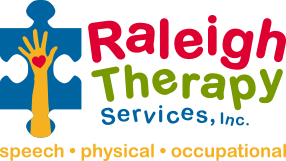October is physical therapy month and so in honor of this, we decided to a Q and A with one our very own physical therapists, Whitney Woodhull-Smith, DPT. Whitney has been with RTS for over 2 years and has served many children and their families. Her experience is vast and she is extremely knowledgeable in her field. We are so proud to have Whitney as a part of the RTS team!
Q: What do pediatric physical therapists do?
A: Pediatric physical therapists work with kids of all ages to help them with their gross motor milestones, strength, and mobility. Regardless of their age or level of function the goal is to achieve their highest potential and have fun while doing it. On any given day I can help a child learn to crawl, walk, go up stairs, propel a wheelchair, or pedal a tricycle.
Q: Why did you decide to become a physical therapist?
I have always wanted to work with kids and became interested in physical therapy towards the end of high school as I was exploring different health related careers. I liked the hands on aspect of physical therapy and knew there would be opportunities to help children in this field.
Q: What do you love the most about your job?
A: I love helping kids! It’s very rewarding to help a child learn to walk! It’s also fun that I get to be silly and sing songs and play all day.
Q: What is your favorite toy to use in therapy?
A: Puzzles and bubbles
Q: What do you like do outside of work?
A: Exercise, read, spend time with family and friends, cook, and cheer on the Tarheels!
Q: What’s your favorite thing to eat?
A: Mexican food and ice cream
Q: What is your favorite ACC team?
A: UNC- Go Heels!
Filed under: Awareness, Physical Therapy, RTS Team
According to research, babies are ready for their parents to begin signing to them around 4 months of age. However, babies typically cannot sign back until approximately 7 to 9 months of age. Signing to babies has proven to be an effective method for increasing language skills.
Some ideas for the first words to sign to baby are:
- All Done-This helps baby to know that something is finished. It can also help with transitions from one activity to another.
- Help-Teaches baby to be able to request when he/she needs help rather than having a tantrum.
- Eat-Baby is able to let mom or dad that the he/she is hungry.
- Drink-Baby is able to communicate that he/she is thirsty.
- Mommy-Baby is able to identify and/or request mommy.
- Daddy-Baby is able to identify and/or request daddy.
- Play-Baby is able to request to play.
* More-A word of caution about this sign. While it is a popular sign to teach babies, it is better for babies to learn more specific signs for specific vocabulary. Many times, once a baby learns this sign, he/she will use it for EVERYTHING so it becomes confusing as to what is being requested. More juice? More food? More play?
Pictures and videos of how to sign the words can easily be found on the internet as well as in baby sign books.
Filed under: Awareness, Parent Education, RTS Team, Speech and Language Development
Since it is spring as well as Better Speech and Hearing Month, we would like to share a simple analogy with parents and teachers to help encourage speech and language development with infants and toddlers. Happy speech and language learning this spring!

Your speech should….
Simple but not “baby talk.” ~Example: Instead of saying “Put your big, blue shoes on the lower shelf when it is time to take a nap and remember to get your mat,” try “Get your mat. Put your shoes up for nap time.”
Pause so that child has time to respond. Reduce the number of questions asked to the child and tolerate silence in between communication exchanges.
Repeat the word you want the child imitate or say. Keep repeating it! ~Example for target word ball: “You have a ball. Let’s throw the ball. Ready, set, go! Throw the ball to me! That’s right! You threw the ball!.”
Interpret what the child says. Say a word another way that might be easier for the child to imitate.
Narrate and talk about what you are doing and what is going on at the time.
Gesture to try and supplement speech with visual gestures and facial expressions.
Filed under: Advocacy, Awareness, Better Speech and Hearing, RTS Team, Speech and Language Development



